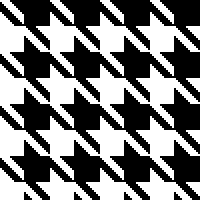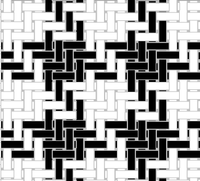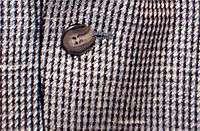Houndstooth
Houndstooth, hounds tooth check or hound's tooth (and similar spellings), also known as dogstooth, dogtooth, dog's tooth, or pied-de-poule, is a duotone textile pattern characterized by broken checks or abstract four-pointed shapes, often in black and white, although other colours are used. The classic houndstooth pattern is an example of a tessellation.
A smaller-scale version of the pattern can be referred to as puppytooth.[1][2]
Design and history
The oldest known occurrence of houndstooth is the Gerum Cloak[3], a garment uncovered in a Swedish peat bog, dated to between 360 and 100 BC.[4] Contemporary houndstooth checks may have originated in woven wool cloth of the Scottish Lowlands,[5] but are now used in many other materials. The traditional houndstooth check is made with alternating bands of four dark and four light threads in both warp and weft/filling woven in a simple 2:2 twill, two over/two under the warp, advancing one thread each pass. In an early reference to houndstooth, De Pinna, a New York City–based men's and women's high-end clothier founded in 1885, included houndstooth checks along with gun club checks and Scotch plaids as part of its 1933 spring men's suits collection.[6] Oversized houndstooth patterns were also employed prominently at Alexander McQueen's Fall 2009 Collection, entitled Horn of Plenty.[7] The patterns were a reference to Christian Dior's signature tweed suits.[8]
See also
References
- ↑ "Ready to Wear: Houndstooth is fierce, and signifies power over and". independent.co.uk. 2 November 2009.
- ↑ "Style hints & tips, everything a gentlemen needs to know about style - Charles Tyrwhitt". www.ctshirts.co.uk.
- ↑ "Gerumsmanteln-Färganalys - Historiska Museet". historiska.se.
- ↑ "Sveriges äldsta bevarade klädesplagg - Historiska Museet". historiska.se.
- ↑ Dunbar, John Telfer: The Costume of Scotland, London: Batsford, 1984, ISBN 0-7134-2534-2, 1984 (paperback 1989, ISBN 0-7134-2535-0)
- ↑ "Gun Club Checks". The New Yorker. New Yorker Magazine, Inc. 9: 28. 1933. OCLC 1760231. Retrieved October 9, 2011.
- ↑ Eric Wilson (11 March 2009). "McQueen Leaves Fashion in Ruins". New York Times. Retrieved 2 November 2015.
- ↑ Sarah Mower (10 March 2009). "Fall 2009 Ready-to-Wear Alexander McQueen". Vogue. Retrieved 2 November 2015.
The clothes were, for the most part, high-drama satires of twentieth-century landmark fashion: parodies of Christian Dior houndstooth New Look and Chanel tweed suits [...]
External links
| Wikimedia Commons has media related to Houndstooth. |





.svg.png)